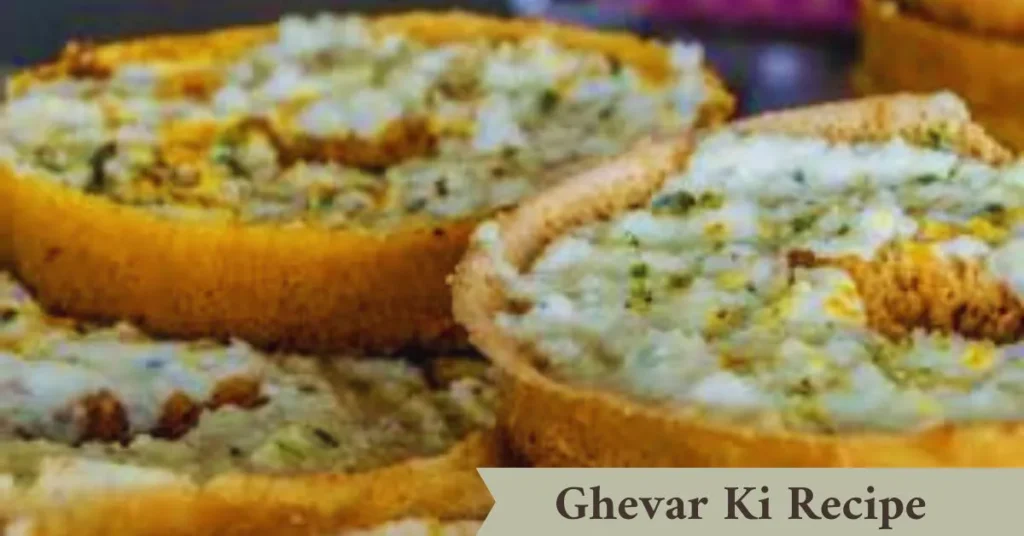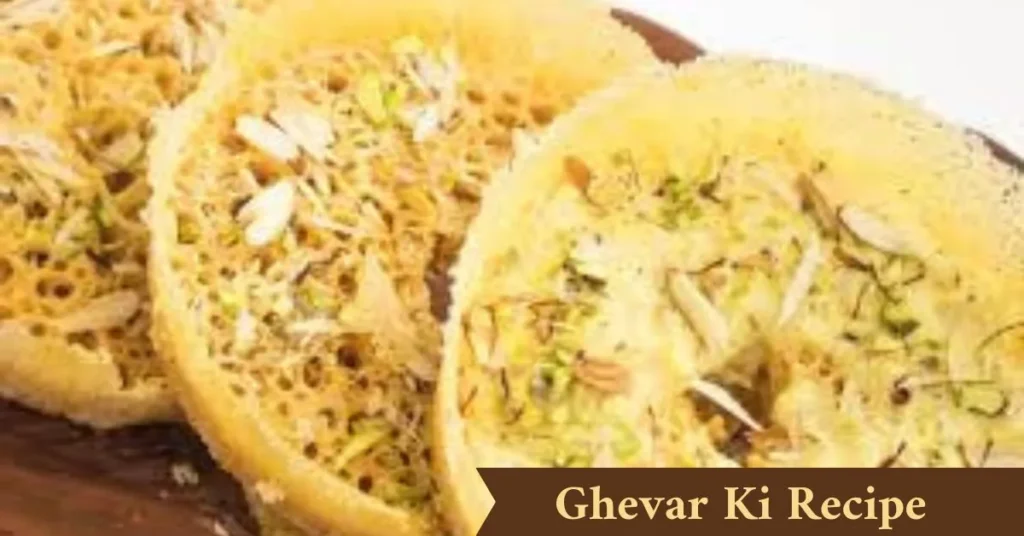With an appetite for sweets and a penchant for exploring novel and indulgent desserts, you will find something to satisfy your cravings! In this article, we venture into the enticing universe of “Ghevar Ki Recipe,” an ancient Rajasthani sweet guaranteed to enter your taste buds. From the pastry’s storied past to the minute details of its preparation, we will offer an exhaustive guide to this indulgent delight.
Ghevar, born in the royal kitchens of Rajasthan, India, is a beloved dessert. The state’s iconic dessert is vital to cultural gastronomy during festivals and other occasions. The unique texture of Ghevar, combined with its decorative toppings, creates an attractive and delicious dish.
1. The Origin of Ghevar Ki Recipe
The heritage of Ghevar stretches back to the early centuries, having been initially introduced in the realm of Rajasthan. The origin story claims this decadent treat was fortuitously crafted when a seasoned chef endeavored to develop a cutting-edge dessert for the royal court. Inadvertently increasing the ghee used, the cook created a novel treat with a distinctive lattice design, renowned as Ghevar.
2. Ingredients Required
To make this enticing dessert at home, you will need the following ingredients:
A pair of cups of all-purpose flour, please.
Ghee equals one measuring cup.
A one-litre container of whole milk.
● 1 cup water
● 1 cup sugar
A tiny bit of saffron
● 1 teaspoon cardamom powder
Finishing with chopped nuts and edible silver foil (silver vark).
3. Step-by-Step Preparation
Making the Ghevar Batter
In a vast mixing vessel, combine the all-around flour and butter. Beat the ingredients together until they take on a texture much like breadcrumbs. Mix the milk and water gradually, consistently whisking the combination to form a fluid batter. Work towards a consistent texture, similar to a thin pour of syrup. Adding these components will give off a mesmerizing aroma.
4.2 Preparing the Sugar Syrup
Within a distinct pan, melt the sugar with hot water. Allow the mixture to heat until a single thread easily passes through it. It will take about 8-10 minutes for this endeavor to be accomplished. When handling the sugar syrup, it should exhibit a sticky quality.
4.3 Frying the Ghevar
Choose a pan that measures both broad and deep, with a smaller bottom. Add ghee and then cook it. After melting the ghee, add a portion of the prepared batter to create organized rings. Cook the Ghevar until it turns light brown and has a satisfying crunch.
4. Unlock the Secrets to Achieving Fluffy, Golden Ghevar Ki Recipe with Our Tutorial
● Chilled Ingredients: When making the batter, cold milk and water must be employed. The incorporation of this step helps ensure a smoother texture.
● Temperature Control: Ensuring the ideal cooking temperature is vital during deep-frying. High heat can lead to burnt Ghevar, while low heat can make it soggy.
● Copper Vessels: Conventional wisdom dictates that copper cooking enhances Ghevar’s culinary experience.
● Garnishing: Get creative with garnishing! Use chopped nuts, silver vark, and even edible rose petals for a stunning presentation.
5. Serving and Garnishing
Submerge the Ghevar in the syrup for a fleeting second, thereby facilitating the absorption of sweetness. Withdraw the object from the syrup and let any excess syrup drop off. Finish the Ghevar by garnishing it with nuts and a faint coating of cardamom powder.
6. Variations of Ghevar Ki Recipe
As the years passed, many Ghevar forms have been developed, accommodating varied flavor profiles and sensibilities. From malai Ghevar to mawa Ghevar and kesariya Ghevar, these variations demonstrate an inventive approach to the traditional dish.
7. The Cultural Significance of Ghevar Ki Recipe
Ghevar assumes great cultural importance in Rajasthan, playing a central role in various festive occasions. Gifts are usually shared among close ones during important gatherings, symbolizing the ties that bind them.
8. Health Considerations
The indulgence of Ghever can result in excessive caloric intake, so it is wise to enjoy it sparingly. Persons with food allergies should exercise vigilance while partaking in this tasty treat.
Conclusion
Ghevar’s delicate lattice structure and heavenly taste reflect the distinctive culinary culture of Rajasthan. Whether savored during special occasions or simply for pleasure, Ghevar promises a lasting, flavorful impact.
FAQs
1. Is it challenging to prepare the Ghevar Ki Recipe from home?
You can create this dish at home with the appropriate materials and adherence to the instructions.
2. May I store Ghevar Ki Recipe for later indulgence?
Airtight storage allows ghevar to remain edible for approximately seven days. At its best, this item tastes superior when consumed directly after opening.
3. What sets Ghevar apart from other beloved Indian desserts?
What distinguishes Ghevar is its complex layout, bee-like surface texture, and how it is submerged in sweet syrup, endowing it with a singular flavor and look.
4. Would you advise modifying the standard Ghevar recipe to cater to vegetarian preferences?
A vegan variation of Ghevar can be created with minor adjustments by swapping ghee for vegetable oils and utilizing milk alternatives free from animal products.
5. Is Ghevar gluten-free?
Wheat flour is an ingredient in Ghevar, which disqualifies it for individuals following a gluten-free regimen.


